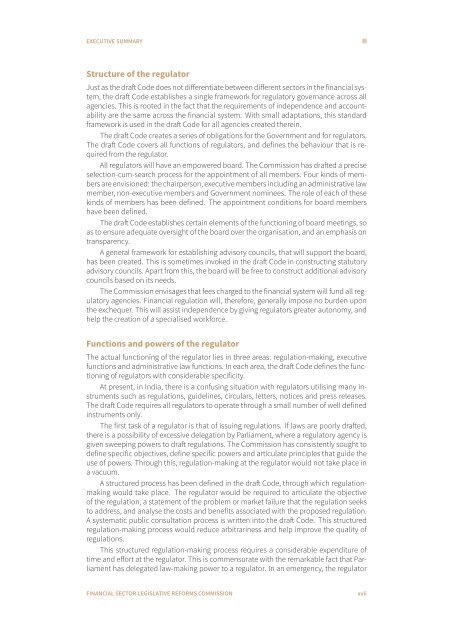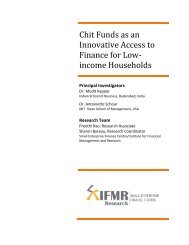Government of India Volume I: Analysis and Recommendations
Government of India Volume I: Analysis and Recommendations
Government of India Volume I: Analysis and Recommendations
You also want an ePaper? Increase the reach of your titles
YUMPU automatically turns print PDFs into web optimized ePapers that Google loves.
EXECUTIVE SUMMARY<br />
Structure <strong>of</strong> the regulator<br />
Just as the draft Code does not differentiate between different sectors in the financial system,<br />
the draft Code establishes a single framework for regulatory governance across all<br />
agencies. This is rooted in the fact that the requirements <strong>of</strong> independence <strong>and</strong> accountability<br />
are the same across the financial system. With small adaptations, this st<strong>and</strong>ard<br />
framework is used in the draft Code for all agencies created therein.<br />
The draft Code creates a series <strong>of</strong> obligations for the <strong>Government</strong> <strong>and</strong> for regulators.<br />
The draft Code covers all functions <strong>of</strong> regulators, <strong>and</strong> defines the behaviour that is required<br />
from the regulator.<br />
All regulators will have an empowered board. The Commission has drafted a precise<br />
selection-cum-search process for the appointment <strong>of</strong> all members. Four kinds <strong>of</strong> members<br />
are envisioned: the chairperson, executive members including an administrative law<br />
member, non-executive members <strong>and</strong> <strong>Government</strong> nominees. The role <strong>of</strong> each <strong>of</strong> these<br />
kinds <strong>of</strong> members has been defined. The appointment conditions for board members<br />
have been defined.<br />
The draft Code establishes certain elements <strong>of</strong> the functioning <strong>of</strong> board meetings, so<br />
as to ensure adequate oversight <strong>of</strong> the board over the organisation, <strong>and</strong> an emphasis on<br />
transparency.<br />
A general framework for establishing advisory councils, that will support the board,<br />
has been created. This is sometimes invoked in the draft Code in constructing statutory<br />
advisory councils. Apart from this, the board will be free to construct additional advisory<br />
councils based on its needs.<br />
The Commission envisages that fees charged to the financial system will fund all regulatory<br />
agencies. Financial regulation will, therefore, generally impose no burden upon<br />
the exchequer. This will assist independence by giving regulators greater autonomy, <strong>and</strong><br />
help the creation <strong>of</strong> a specialised workforce.<br />
Functions <strong>and</strong> powers <strong>of</strong> the regulator<br />
The actual functioning <strong>of</strong> the regulator lies in three areas: regulation-making, executive<br />
functions <strong>and</strong> administrative law functions. In each area, the draft Code defines the functioning<br />
<strong>of</strong> regulators with considerable specificity.<br />
At present, in <strong>India</strong>, there is a confusing situation with regulators utilising many instruments<br />
such as regulations, guidelines, circulars, letters, notices <strong>and</strong> press releases.<br />
The draft Code requires all regulators to operate through a small number <strong>of</strong> well defined<br />
instruments only.<br />
The first task <strong>of</strong> a regulator is that <strong>of</strong> issuing regulations. If laws are poorly drafted,<br />
there is a possibility <strong>of</strong> excessive delegation by Parliament, where a regulatory agency is<br />
given sweeping powers to draft regulations. The Commission has consistently sought to<br />
define specific objectives, define specific powers <strong>and</strong> articulate principles that guide the<br />
use <strong>of</strong> powers. Through this, regulation-making at the regulator would not take place in<br />
a vacuum.<br />
A structured process has been defined in the draft Code, through which regulationmaking<br />
would take place. The regulator would be required to articulate the objective<br />
<strong>of</strong> the regulation, a statement <strong>of</strong> the problem or market failure that the regulation seeks<br />
to address, <strong>and</strong> analyse the costs <strong>and</strong> benefits associated with the proposed regulation.<br />
A systematic public consultation process is written into the draft Code. This structured<br />
regulation-making process would reduce arbitrariness <strong>and</strong> help improve the quality <strong>of</strong><br />
regulations.<br />
This structured regulation-making process requires a considerable expenditure <strong>of</strong><br />
time <strong>and</strong> effort at the regulator. This is commensurate with the remarkable fact that Parliament<br />
has delegated law-making power to a regulator. In an emergency, the regulator<br />
FINANCIAL SECTOR LEGISLATIVE REFORMS COMMISSION xvii



